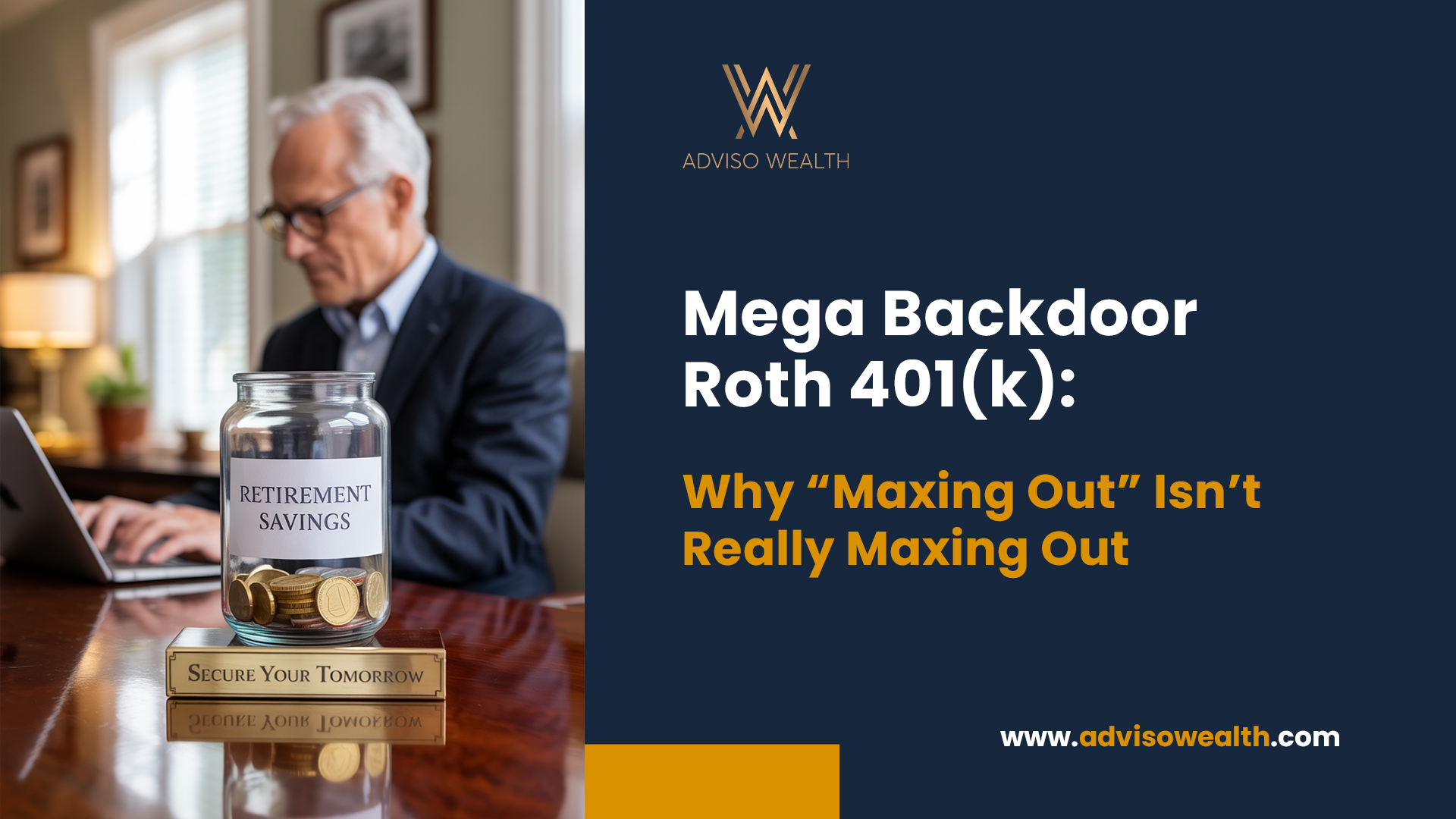Mega Backdoor Roth 401(k): Why “Maxing Out” Isn’t Really Maxing Out

Every January, the IRS updates retirement contribution limits. Every spring, high earners have the same conversation with their CPA:
“You’ve maxed out your 401(k) contributions for the year. Congratulations.”
But for business owners and executives, that’s rarely how it feels. Because “maxing out” in 2025 means an elective deferral of $23,500 (or $31,000 if you’re 50–59, $34,750 if you’re 60–63). Even if you add employer contributions, the cap is $70,000. Catch-up contributions are allowed on top of that—so $77,500 (ages 50–59) or $81,250 (ages 60–63).
If you’re running a business generating millions, those caps feel less like a benefit and more like a bottleneck. You have the cash flow. You want to save more. And yet the system shuts the door.
Unless you know about the Mega Backdoor Roth 401(k).
What Is a Mega Backdoor Roth 401(k)?
The Mega Backdoor Roth 401(k) is an advanced retirement strategy that allows high earners to bypass traditional Roth IRA income limits and contribute tens of thousands more dollars into Roth accounts—every single year.
It works by making after-tax 401(k) contributions beyond the standard elective deferral, then converting those contributions into Roth dollars (either in-plan or through an in-service rollover to a Roth IRA).
The payoff? More of your wealth compounds tax-free for life.
2025 Mega Backdoor Roth Contribution Limits
Here are the official IRS numbers for 2025:
- Employee elective deferral limit (402(g)):
- $23,500 under age 50
- $31,000 if age 50–59 (includes $7,500 catch-up)
- $34,750 if age 60–63 (includes $11,250 “super catch-up”)
- Annual additions limit (415(c)):
- $70,000 total (employee + employer + after-tax, excluding catch-up)
- Total possible contribution:
- Up to $77,500 if age 50–59
- Up to $81,250 if age 60–63
This makes the Mega Backdoor Roth one of the only ways a business owner can legally funnel $70K+ per year into retirement—and convert much of it into Roth status.
How the Mega Backdoor Roth 401(k) Works (Step by Step)
- Contribute your regular deferral.
Example: $23,500 pre-tax or Roth. - Add employer match or profit sharing.
Suppose your company adds $15,000. - Fill the gap with after-tax contributions.
Total contributions (employee + employer + after-tax) can’t exceed $70,000 in 2025. With $23,500 + $15,000 = $38,500 already contributed, you have $31,500 left for after-tax contributions. - Convert to Roth.
- If the plan allows, convert immediately in-plan to Roth.
- If not, roll over after-tax contributions to a Roth IRA through an in-service distribution.
Enjoy tax-free compounding.
Once converted, every dollar grows tax-free—forever.
Mega Backdoor Roth 401(k) Example: $1 Million of Tax-Free Wealth
Let’s do the math.
- Annual Mega Backdoor Roth contributions: $25,000
- Time horizon: 20 years
- Growth rate: 7%
Future Value Formula:
[
FV = 25,000 \times \frac{(1.07)^{20} – 1}{0.07}
]
[
FV = 25,000 \times 40.995 = 1,025,000
]
That’s just over $1 million of Roth assets in 20 years. All tax-free at withdrawal.
Put plainly: Contributing an extra $25K–$30K annually through a Mega Backdoor Roth could potentially compound into $1M+ of tax-free wealth over 20 years.
Why the Mega Backdoor Roth 401(k) Is Ideal for Business Owners
- You control the plan. Employees are stuck with HR, but as an owner, you can amend your 401(k) to allow after-tax contributions and conversions.
- You gain flexibility. Features like in-service withdrawals and auto-conversions can be built in.
- You align business + personal wealth. The Mega Backdoor Roth fits directly into your tax strategy, exit planning, and long-term legacy goals.
What to Ask Your 401(k) Plan Administrator
Before you assume the Mega Backdoor Roth 401(k) strategy works for you, confirm the details. Here are the must-ask questions:
- After-tax contributions: Does the plan allow non-Roth, after-tax contributions?
- In-plan Roth conversions: Can after-tax contributions be converted to Roth inside the plan? How often—immediately, quarterly, or annually?
- In-service withdrawals: If not, can after-tax contributions be rolled to a Roth IRA while still employed?
- Separate accounting: Are after-tax contributions tracked in their own subaccount, avoiding pro-rata complications?
- Payroll and fees: Since contributions are made via payroll (not lump sum), what per-pay limits and fees apply?
Also confirm:
- Employer contributions reduce the $70,000 cap.
- Catch-up contributions are always on top of the $70,000.
For ages 60–63, the $11,250 “super catch-up” applies, raising the ceiling to $81,250.
Risks and Pitfalls of the Mega Backdoor Roth 401(k) Plan
- Pro-rata rule risk. If rolled into an IRA, after-tax contributions can get tangled with pre-tax balances, triggering tax. Better to convert in-plan or ensure subaccounting.
- Liquidity concerns. These are retirement dollars—don’t sacrifice business cash flow.
- Coordination gaps. The strategy touches tax, payroll, and wealth planning. Your CPA and advisor need to work together.
Mega Backdoor Roth 401(k) vs. Other Roth Strategies
- Standard Roth IRA: $7,000 ($8,000 if 50+) in 2025, phased out at $163K/$246K income. Tiny compared to the Mega option.
- Backdoor Roth IRA: A workaround for high earners, but limited to IRA caps.
- Roth 401(k) contributions: $23,500 (or $31,000/$34,750 with catch-ups). Still capped.
- Mega Backdoor Roth 401(k): Up to $70,000 + catch-up. The only strategy that allows six figures of Roth contributions for business owners.
Why the Mega Backdoor Roth 401(k) Matters
The Mega Backdoor Roth isn’t a loophole. It’s a plan design decision.
For business owners, it’s about control and compounding:
- Control over your tax-free vs. tax-deferred mix.
- Control when future tax laws inevitably shift.
- Control over leaving assets to heirs tax-free.
And compounding? That’s where the magic happens. Over decades, funneling $25K–$35K annually into Roth status can create multi-million-dollar tax-free pools of wealth.
Next Steps for Business Owners
- Review your plan documents.
- Ask your administrator the five key questions.
- Run projections with your CPA and advisor.
- If needed, amend your plan—it’s your business, your rules.
Final Word
Most business owners don’t know the Mega Backdoor Roth 401(k) strategy exists. Fewer have the right plan design to implement it. But those who do are setting up decades of tax-free compounding, while everyone else keeps hitting arbitrary ceilings.
The IRS has its limits. Smart business owners design around them.
Disclaimer
All written content is for information purposes only. Opinions expressed herein are solely those of Adviso Wealth, unless otherwise specifically cited. Material presented is believed to be from reliable sources and no representations are made by our firm as to another parties’ informational accuracy or completeness. All information or ideas provided should be discussed in detail with an advisor, accountant or legal counsel prior to implementation.
